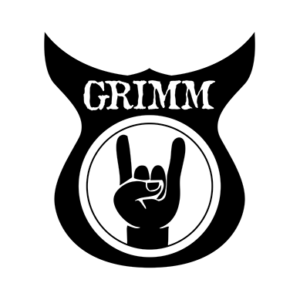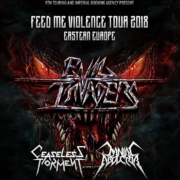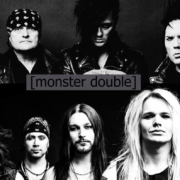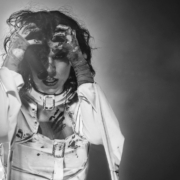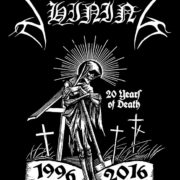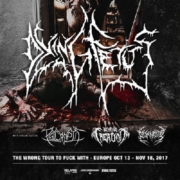2016 might just be the year for Einar Selvik of Wardruna. Together with Ivar Bjørnson of Enslaved he released the album version of the epic masterpiece Skuggsjá (review) which was critically acclaimed all over the world and will end up high in many year lists (I know it is in mine). In the fall he unleashed Ragnarok upon the world. Luckily not as the Norse mythological ending of the world, but as the closing chapter of the Runaljod album trilogy. Again, the praise was plentiful, also among our Grimm reviewers. The album was not presented live in Belgium, but luckily our northern neighbours were graced with two sold out show in the Tivoli Vredenburg theater. So just as in the music, we travelled north.
The Tivoli theater is an impressive building with five different concert halls and comfortable accommodation for both seated and standing audiences. We had no trouble finding a spot with a perfect view on the stage from one of the balconies in the Pandora hall. My biggest question of the night was: how does Wardruna perform so many authentic and natural sounds live? My contemplations were partially answered by the close to twenty instruments that were spread over the stage. I won’t even try to name them all. From the crafted instruments to natural wood blocks and animal horns, the violin was probably the most modern one, so you can go figure. The only ‘instruments’ I missed were the streaming water or ice percussion that is audible on some album tracks. The concert was blasted off by the large horns introducing the opening song Tyr of the latest Ragnarok album. Slowly you learned how every piece of instrument contributed to the overall sound experience that is called Wardruna.
But then I did not mention the voices yet. The voices of the six musicians on stage joined together is an enchanting thing to hear. Ritualistic, as if in a trance they draw you in another realm, forgetting the modern world around you. This is helped by the intricate light play on the curtain behind the ensemble. While at one time you imagine icy fields, at other times you feel the warmth of golden fields or the lure of the green northern forests. Two voices deserve more attention. Lindy-Fay Hella is the female force in the band and even when she is not drawing you closer with her captivating voice she demands your attention by the rhythmic movements she performs on the music and deep drum beats. And then there is Einar Selvik himself of course. Other writers have compared him with the Norse god of poetry Bragi himself. It is a bold statement to make, but the man mesmerizes the audience with his chanting lyrics and intimidates when he lashes out with great fervor. He manages to make a breath or a whisper part of the songs he creates. You might not understand a word of the language he chants in, but you feel the power residing in the songs, just like the runes he sings about.
Only before the last song – Helvegen – Selvik spoke directly to the audience. First of all, to thank us for the two rapidly sold out shows and secondly to tell us a little bit about the philosophy of his project. He does not wish to re-create the old and lost, but rather forge new songs about our contemporary society with old materials. Seldom have I heard such silence between songs, only to be contrasted with the deafening applause between them. You will probably have figured it out by now and I will not lie to you; I am blown away and this was the best show of 2016 for me. We heard songs from all three albums and it is sad to contemplate the Runaljod trilogy is finished. I certainly hope we soon hear more about Selvik‘s future plans about themes for Wardruna so we can look forward to new compositions.
